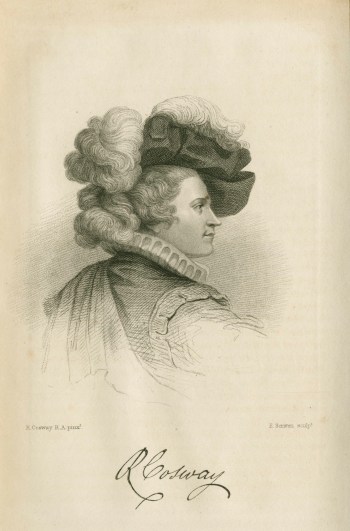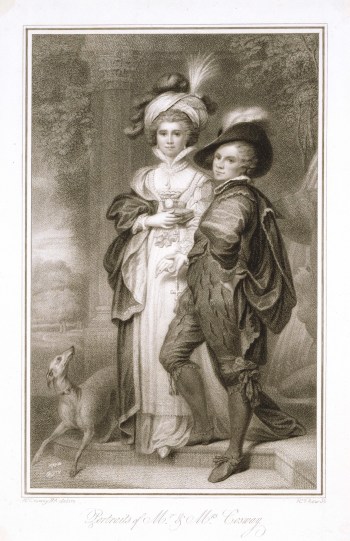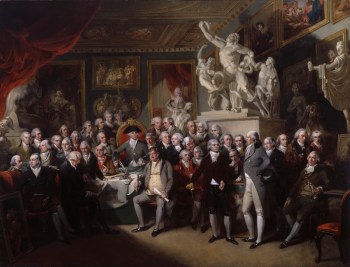Richard Cosway RA (1742? - 1821)
RA Collection: People and Organisations
Richard Cosway was born near Tiverton, Devon. Aged twelve, he was sent to London to train as an artist. He studied at the academy run by William Shipley, where fellow pupils included Ozias Humphry, who later also became a Royal Academician.
In 1760 Cosway embarked upon a career as an independent artist, swiftly establishing himself as a society portraitist. He produced miniatures and drawings ‘stained’ or ‘tinged’ with watercolour. In the 1760s, he exhibited regularly at the Society of Arts and the Free Society of Artists. These provided opportunities to showcase his ambitious oil portraits, rather than his fashionable miniatures and drawings.
The Royal Academy, founded in 1768, elected few miniaturists, a possible reason for why Cosway chose to exhibit his oil paintings. In 1769 Cosway was admitted as a student to the Academy schools (a prerequisite for later membership), leading to his election as one of the first Associates in 1770. He became a full Member in 1771, exhibiting in the annual exhibition until 1806. In Zoffany’s group portrait of the Academicians (1771-2), Cosway occupies a prominent position on the far right, painted full-length with an elegant and refined appearance.
In the 1780s Cosway married the artist and musician Maria Hadfield. They operated a fashionable salon from their Pall Mall residence, with the Gainsboroughs as their immediate neighbours. During this time, Cosway attracted the patronage of George, Prince of Wales (later George IV) for whom he worked for the next 30 years, producing numerous paintings of the Prince and his close circle.
The most fashionable portrait miniaturist of the late eighteenth century, Cosway’s mature style epitomised early Regency taste. Cosway was prolific, creating up to twelve portraits in a single day. He also collaborated with engravers to reproduce his work for a wider public.
Cosway was also renowned as a connoisseur, virtuoso and collector. He assembled an outstanding art collection including works by Rubens alongside valuable armour, furniture and decorative objects. Following his death in 1821, this much-admired collection was sold at auction, where Sir John Soane bought over 30 objects for his own collection.
RA Collections Decolonial Research Project - Extended Case Study
Throughout the 1780s, Maria and Richard Cosway established themselves at the centre of London high society, exhibiting works at the Royal Academy’s Annual Exhibition, hosting musical soirées for fashionable company, painting portraits of eminent individuals and even publishing original music compositions.
In 1784, the Cosways moved to a grand apartment in Schomberg House on Pall Mall. It was around this time that they began to employ a Black servant, Quobna Ottobah Cugoano (c.1757–c.1791), also known as John Stuart. Cugoano was born in modern-day Ghana; he was captured by African traders in 1770, sold into enslavement to Europeans and trafficked across the Atlantic to Grenada. After two years of enforced labour in Grenada, Cugoano was taken to England by his owner, a merchant called Alexander Campbell. The circumstances in which Cugoano regained his freedom are unclear, but it was possibly linked to the judgement in the Somerset case of 1772, in which the judge ruled that ‘no master ever was allowed here (in England) to take a slave by force to be sold abroad because he deserted from his service…therefore the man must be discharged’. This was taken by some supporters of abolition as proving that enslavement had no legal standing on English soil (see Notes, 1).
Cugoano was an influential campaigner calling for abolition of the slave trade and the end of enslavement of Africans. Through his employment with the Cosways, he met several notable artists and public figures including King George III, the Prince of Wales, and Sir Edmund Burke, to whom he petitioned and wrote letters calling on their support for abolition. In 1786, with another Afro-Briton William Green, he appealed to the anti-slavery campaigner Granville Sharp (1735–1813) to prevent a man named Harry Demane from being forced into slavery in the West Indies. Cugoano published a treatise entitled Thoughts and Sentiments on the Evil and Wicked Traffic of the Slavery and Commerce of the Human Species in 1787. A shorter version of the book was published in 1791, with subscribers including prominent artists such as Sir Joshua Reynolds, James Northcote and Joseph Nollekens, indicating their support of Cugoano’s mission (see Notes, 2). Richard Cosway also subscribed to the volume, and Schomberg House was listed as a place where potential readers could acquire a copy of the 1787 edition (See Notes, 3). These considerations imply that the Cosways were supportive of ending enslavement.
Cugoano was portrayed by Richard Cosway in an etching from 1784, showing the artist and his wife supposedly in the garden of Schomberg House. It is difficult to clearly interpret Cosway’s intentions for including Cugoano in this intimate marital self-portrait. On the one hand, it implies that Cosway wanted to be associated with Cugoano, who is depicted as himself, rather than as a generalised ‘type’. However, it was not unusual for eminent figures to be portrayed with Black attendants as a statement of their wealth and sophistication (see Notes, 4). In this context, Black people were associated with the riches of the empire and ‘exotic’ cultures, aspirational attributes for wealthy Georgians. Cugoano’s presence in this scene was possibly intended to increase the Cosways’ social standing. Unlike similar contemporary works, though, Cugoano is shown at the centre of this composition, apparently presented on an equal standing with the Cosways. The Royal Collection Trust suggests that Cugoano ‘interacts with them elegantly rather than subserviently, standing over Maria and handing her a bunch of grapes as if he were an angel in a composition of the Rest on the Flight into Egypt’ (see Notes, 5).
Another matter that connects the Cosways with enslavement stems from Maria’s friendship with Thomas Jefferson (1743–1826) that began in 1786. Maria initially met Jefferson while on a trip to Paris, where he was the American minister to France. He formed an attachment to Maria and wrote a moving account of his feelings for her in a letter of October 1786. They corresponded frequently and Maria visited Jefferson again in Paris in 1787. Jefferson nevertheless kept an engraving of Maria at his estate in Monticello and Maria kept the portrait of Jefferson by John Trumbull in her residence at Lodi, where she lived following the death of her husband (see Notes, 6). Jefferson owned enslaved people, many of whom undertook enforced labour at Monticello, both on the tobacco plantation and on the construction of the now-famous house. Maria’s personal affection for Jefferson adds a layer of complexity to our understanding of her opinion of enslavement. In one letter to Jefferson from 1822, she describes her desire to visit ‘your charming Monticello’ where she knew enslaved people were kept. Passive acceptance of Jefferson’s personal involvement in slavery suggests that she did not consider this as incompatible with her support and employment of the anti-slavery campaigner Cugoano.
It is also worth noting that Maria’s brother, the architect George Hadfield (1763-1826) designed many buildings in America including Arlington House, Virginia, built for the plantation owner and author George Washington Parke Custis. Custis owned hundreds of enslaved people, mostly in the state of Virginia. Maria somewhat lost touch with her brother after his move to America in 1795 and would not have personally benefited from such commissions (see Notes, 7). However, this example underlines how the artistic sphere at this time was closely bound up with profits from enslavement.
Notes
https://www.nationalarchives.gov.uk/pathways/blackhistory/rights/slave_free.htm (accessed 1 March 2022).
Ottobah Cugoano, Thoughts and sentiments on the evil or slavery; Or, the nature of servitude as admitted by the law of God, compared to the modern slavery of the Africans in the West-Indies; in an answer to the advocates for slavery and oppression. Addressed to the sons of Africa, by a native (London, 1791); https://link.gale.com/apps/doc/CB0126566527/ECCO?u=lonlib&sid=bookmark-ECCO&xid=f994b30d&pg=1 (accessed 1 March 2022).
Ottobah Cugoano, Thoughts and sentiments on the evil and wicked traffic of the slavery and commerce of the human species. Humbly submited to the inhabitants of Great-Britain by Ottabah Cugoano, a native of Africa (London 1787); https://link.gale.com/apps/doc/CB0127577840/ECCO?u=lonlib&sid=bookmark-ECCO&xid=5e27d67b&pg=1 (accessed 1 March 2022).
http://www.vam.ac.uk/content/articles/s/silver-service-slavery-the-black-presence-in-the-white-home/ (accessed 1 March 2022).
https://www.rct.uk/collection/653010/a-self-portrait-with-maria-cosway-and-ottobah-cugoano (accessed 1 March 2022).
https://www.monticello.org/site/research-and-collections/maria-cosway-engraving (accessed 1 March 2022).
https://founders.archives.gov/documents/Jefferson/98-01-02-2944 (accessed 1 March 2022).
Relevant ODNB entries
Lloyd, Stephen. “Cosway, Richard (bap. 1742, d. 1821), artist and collector.” Oxford Dictionary of National Biography. 23 Sep. 2004; Accessed 1 Mar. 2022. https://www-oxforddnb-com.lonlib.idm.oclc.org/view/10.1093/ref:odnb/9780198614128.001.0001/odnb-9780198614128-e-6383.
Lloyd, Stephen. “Cosway [née Hadfield], Maria Louisa Catherine Cecilia, Baroness Cosway in the nobility of the Austrian empire (1760–1838), history painter and educationist.” Oxford Dictionary of National Biography. 23 Sep. 2004; Accessed 1 Mar. 2022. https://www-oxforddnb-com.lonlib.idm.oclc.org/view/10.1093/ref:odnb/9780198614128.001.0001/odnb-9780198614128-e-6382.
Carretta, Vincent. “Cugoano, Ottobah [John Stuart] b. 1757?, slavery abolitionist and writer.” Oxford Dictionary of National Biography. 23 Sep. 2004; Accessed 1 Mar. 2022. https://www-oxforddnb-com.lonlib.idm.oclc.org/view/10.1093/ref:odnb/9780198614128.001.0001/odnb-9780198614128-e-59531.
Darley, Gillian. “Hadfield, George (1763–1826), architect.” Oxford Dictionary of National Biography. 23 Sep. 2004; Accessed 1 Mar. 2022. https://www-oxforddnb-com.lonlib.idm.oclc.org/view/10.1093/ref:odnb/9780198614128.001.0001/odnb-9780198614128-e-11854.
Profile
Born: 1742? in Devon
Died: 4 July 1821
Nationality: British
RA Schools student from 09 August 1769
Elected ARA: 27 August 1770
Elected RA: 15 March 1771
Gender: Male
Preferred media: Painting and Miniature painting
Works by Richard Cosway in the RA Collection
2 results
Works after Richard Cosway in the RA Collection
7 results
-

Henry Dawe
Rinaldo and Armida
Mezzotint
-

After Richard Cosway RA
Portrait of Mrs Cosway, 1791
Stipple engraving
-
![Richard Cosway RA, 'Melania' [i.e. Mrs Mary Robinson]](#)
After Richard Cosway RA
'Melania' [i.e. Mrs Mary Robinson]
Stipple engraving
-

After Richard Cosway RA
Self-portrait, published ca. 1832?
Stipple engraving
-

After Richard Cosway RA
Portrait of Paul Sandby, R.A.
Stipple engraving
-

After Richard Cosway RA
Mr. & Mrs Cosway, 1 June 1789
Stipple engraving
-

Francesco Bartolozzi RA
Venus and Adonis, 1778
Stipple engraving
Works associated with Richard Cosway in the RA Collection
14 results
-

George Dance RA
Portrait of Richard Cosway, R.A., 6 April 1793
Pencil with black, pink and blue chalks on cream wove paper
-

Henry Singleton
The Royal Academicians in General Assembly, 1795
Oil on canvas
-

Conrad Martin Metz
Pietá attributed to Michelangelo, 1789
Etching and aquatint
-

Conrad Martin Metz
Leda and the Swan attributed to Raffaello , 1789
Etching and aquatint
-

Conrad Martin Metz
Hercules and the Nemean Lion attributed to Giulio Romano, 1789
Etching and aquatint
-

Conrad Martin Metz
Perseus Freeing Andromeda attributed to Giulio Romano , 1789
Etching and aquatint
-

Conrad Martin Metz
Female figure with a lion, a horse and an aries attributed to Giulio Romano, 1789
Etching and aquatint
-

Conrad Martin Metz
Madonna and Child attributed to Annibale Carracci, 1789
Etching and aquatint
-

Conrad Martin Metz
Two putti holding a palm leave attributed to Taddeo Zuccari, 1789
Etching and aquatint
-

Conrad Martin Metz
The death of Adonis attributed to Giulio Romano, 1789
Etching and aquatint
-

Conrad Martin Metz
God creating the earth attributed to Parmigianino, 1789
Etching and aquatint
-

Conrad Martin Metz
Sacrifice scene attributed to Raffaello , 1789
Etching and aquatint
-

Conrad Martin Metz
Nativity attributed to Federico Barocci , 1789
Etching and aquatint
-

Conrad Martin Metz
Head of woman and other figures in the background attributed to Michelangel, 1789
Etching and aquatint
Associated books
5 results
-
Vincenzo Cartari
Le Imagini De I Dei De Gli Antichi, Nelle Quali Si Contengono gl'Idoli, Riti, Ceremonie, & altre cose appartenenti alla Religione de gli Antichi, Racolte dal Sig. Vincenzo Cartari, con la loro espositione, & con bellissime & accommodate figure novamente ristampate. Et con esservi citati i luoghi de gli auttori stessi, di donde molte cose sono state cavate, con molta diligentia riviste, & corrette. - In Lione: 1581.
03/2239
-
Richard Morton Paye
Etchings, by & from the most esteem'd English artists - [s.l.]: c.1875]
05/341
-
Karl Theodor von Dalberg
Périclès : de l'influence des beaux-arts sur la félicité publique / par Charles d'Alberg - A Parme: 1811
04/3323
-
George C. Williamson
Richard Cosway R.A. - London: 1905
08/3591




![Richard Cosway RA, 'Melania' [i.e. Mrs Mary Robinson]](https://d1inegp6v2yuxm.cloudfront.net/royal-academy/image/upload/c_limit,cs_tinysrgb,dn_72,dpr_auto,f_auto,fl_progressive.keep_iptc,w_350/s1k61qtqkvro9vq3fhzq.jpeg)

















